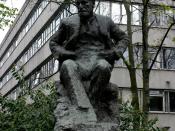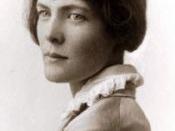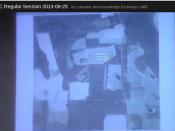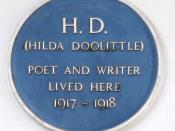In novelistic method, in language, and in sheer sensuous richness, HERmioneÃÂa book written more than fifty years ago about events even earlier in the authorÃÂs lifeÃÂdemands recognition as among the most timely and timeless of books. Its author, now dead, matured with the century. Hilda Doolittle became H. D., Imagiste, at the promoting of her one-time fiancé Ezra Pound. The place was London, the year 1912. Hilda Doolittle had allowed Pound to convince her to follow him to Europe, and was in the process not so much of falling out of love with the American self-styled troubadour or of falling in love with the young British poet Richard Aldington as she was coming to grips with what Pound wanted her to beÃÂa muse, H. D.ÃÂs biographer says, a decoration.
In a London tearoomÃÂaccording to Janice S. RobinsonÃÂPound dubbed Aldington and Doolittle Imagists, and set out to get them published in the then-new Poetry magazine in Chicago.
PoundÃÂs launching the Imagist movement, using H. D. as its prime example, was crucial to her life and important for the history of twentieth century poetry. Soon, H. D. would be Mrs. Richard Aldington, and Pound would be married to Dorothy Shakespear, a marriage that placed him at the heart of a literary circle which included William Butler Yeats, the poet he admired most in English. H. D.ÃÂs attachment to Pound would remain strong over the years, as indicated by her repeated use of him in her writing. As late as 1958, PoundÃÂs anticipated release from St. ElizabethÃÂs Asylum prompted H. D. to reexamine their relationship in End to Torment (1979). Her psychoanalysis with Sigmund Freud required much talk about Pound, as about other lovers, Aldington and D. H. Lawrence; H. D.ÃÂs Tribute to Freud (1956) takes its place with H. D.ÃÂs poetry and fiction, some of it still unpublished, as part of the record of how a remarkable woman took charge of her own life at a time when women did so at their peril.
HERmione may be said to be the first chapter in a feminist odyssey. The classically schooled Hilda Doolittle (no matter that Pound was her most important teacher) was prepared to see her life as myth, and, beginning in 1933, Freud helped her sort the materials. In a letter two years before her death, H. D. instructed her literary executor to destroy the manuscripts of two works written in London between 1926 and 1927. One of them was HERmione, a book which establishes that she had already begun to pattern her own myths.
In HERmione, H. D. identifies herself with William ShakespeareÃÂs misunderstood queen in The WinterÃÂs Tale (1610-1611) and with the Greek Hermione, daughter of Menelaus and Helen of Troy. HERmione, as the capitalization of the feminine pronoun suggests, is about essential woman, and Hermione Gart characteristically thinks of herself as ÃÂHer,ÃÂ though, at crucial moments, she confuses the ÃÂHerÃÂ which is herself with the ÃÂHerÃÂ which is Fayne Rabb. The story occurs near Philadelphia in about 1905, though H. D. compresses events for the sake of dramatic intensity.
The opening pages of HERmione reveal Hermione Gart as a young woman convinced she is a failure, for she has failed conic sections at Bryn Mawr and seems, thus, to be closed out of the scientific talk of her father and brother. She cannot bring herself to think of her brotherÃÂs self-assured, somewhat common wife Minnie as her sister and wants nothing more than to be at the beach alone with a dog of her ownÃÂsomething she does not have to share. She must share even the homely task of picking up the mail with the hateful Minnie, whom she thinks of as red-hairedÃÂa zinnia, that coarsest and gaudiest of flowers.
The dayÃÂs mail brings an invitation from a former classmate to come meet a woman who is as fey as she is, and it brings word that George Lowndes is coming home to ÃÂGodÃÂs own god-damned country.ÃÂ The fey young woman and George Lowndes provide the bookÃÂs dramatic conflict: eventually, Her sees George as a wolf, ÃÂa wolf mask on a manÃÂs body,ÃÂ and Fayne Rabb as the looked-for sister and as a swallow, the swallow of A. C. SwinburneÃÂs poem. ÃÂO sister my sister O singing swallow,ÃÂ Hermione sighs.
As a novel, HERmione lives less in its action than in the sensibility of its protagonist, reminding one that another of H. D.ÃÂs contemporaries, James Joyce, declared unequiovocally that the quality of art depends upon the richness of the mind of its creator. The third-person point of view never deviates from its close, sometimes almost suffocating focus on Hermione Gart. The narrative allows Hermione to know the events of her life from all possible perspectives at once, and from the start, the third-person voice creates the effect of near-madness: a schizophrenic playing across the mindÃÂs screen a drama in which she herself (Her herself?) is a principal player. The overlay of images creates effects at once cubistic and surreal.
In technique, HERmione rivals the major accomplishments of H. D.ÃÂs contemporary Virginia Woolf. Both artists treat time for what it isÃÂa fluid medium allowing for change but not so much flowing as piling up in levels ever deeper, ever more suggestive of the momentÃÂs potential. The novelÃÂs structure depends far more upon the recurrence of phrase, image, and mood than upon mere progression of events. Sentences and paragraphs appear to reach forward and lean backward simultaneously, and the book manages to sketch a real person by recording the repetitiveness of a mindÃÂs activity.
Hermione Gart recites a formula affirming her very special identity; for her, words are in things and things in words. She conjures with words, and conjuring frightens her. The elements of the formulae she utters become the talismanic cornerstones of HerÃÂs being and of the book. Early in the novel, she says, ÃÂI am Hermione Gart, a failure.ÃÂ Later, in her room with the two letters which will so profoundly affect her, she sees two books, one a volume of Shakespeare: ÃÂI am out of this book.ÃÂ The other book frightens her, for there she sees the words ÃÂI am the word AUM.ÃÂ She drops the book, wondering ÃÂif she had offended anything,ÃÂ but the formula is at work on her: ÃÂI am the word . . . the word was with God . . . I am the word . . . HER.ÃÂHermione identifies with Aum and with nature. ÃÂI am the word Aum and I am Tree. I am Tree exactly . . . I knew George could never love a tree properly.ÃÂ Trees named on the bookÃÂs first page become a litany, ÃÂDogwood, liriodendron with its green-yellow tulip blossoms.ÃÂ People bring to HerÃÂs mind trees and flowers; she categorizes them allÃÂMinnie the zinnia, Dr. Gart the oak tree, George Lowndes the hibiscus flower. The name Pennsylvania becomes obsessive for her: ÃÂPeople ought to think before they call a place Sylvania.ÃÂ HerÃÂs formulae, the names of trees and flowers, patterned and sometimes convoluted, reflect HerÃÂs confused quest for self. Those images also provide the emotional terms for the bookÃÂs chief conflicts.
After apparently losing both George Lowndes and Fayne Rabb, Hermione falls ill and, after nearly missing winter, she returns to health sufficiently to see guests and to walk in the snow. A Norwegian pine seems to her a world in itself, ÃÂOlympian,ÃÂ and she recalls the red hibiscus of her imagination and fevered dreams ÃÂwith a sort of vicarious shudder.ÃÂ Red hibiscus makes her think of a tissue flower in ÃÂsome Nice carnival,ÃÂ and the image seems to represent the Europe to which George Lowndes had wanted to take her. Thinking of that Europe, she tries to remember paintings on ceilings, and leaning her head back says aloud, ÃÂOld paint, paint peeling off. . . . WhatÃÂs that to this thing?ÃÂ This thing is the Norwegian pine. She catches at the tree and thinks, ÃÂGeorge could never love anything properly.ÃÂWithin a few pages, however, Hermione is talking with a young neighbor and his college friend about joining them on a trip to Europe, but the image pattern of the book encourages belief that Hermione has rejected her would-be male lover George Lowndes in favor of the natural female principle. The intention becomes even clearer with the bookÃÂs somewhat surprising final sentence. While Hermione has walked, thinking both George and Fayne are lost to her, Fayne has been in HermioneÃÂs room awaiting her return.
When H. D. did make that trip to Europe, she went in the company of Frances Gregg and FrancesÃÂ mother. FrancesÃÂ later marriage, to an English teacher, was for the express purposeÃÂas she wrote to H. D.ÃÂof remaining in Europe with H. D. In ÃÂA PostludeÃÂ to HERmione, H. D. reports that Ezra Pound got wind of her plan to travel with the newlyweds and prevented her doing so. Frances Gregg was killed by a bomb during the World War II, and among her effects was found HildaÃÂs Book, poems Pound had written for H. D. possibly during the time of events of HERmione.
The conflicts in Her GartÃÂs mind, as well as their possible solution, exist before either George Lowndes or Fayne Rabb enter the story. In her room GeorgeÃÂs letter announcing his return and with her schoolmateÃÂs letter asking her to come meet another girl who is fey too, ÃÂHermione Gart hugged HER to Hermione Gart. I am HER. The thing was necessary.ÃÂ What Hermione recognizes as necessary is the reaffirmation of her identity, her name which ÃÂwas ballast to her lightheadedness.ÃÂ She sits in a low chair, thinking that there she would be heavier than ÃÂflung tossed down like some tree branch on the wide bed.ÃÂ In retrospect, after the birth of her daughter Perdita (HermioneÃÂs daughter in The WinterÃÂs Tale), H. D. told the story of that year back home in Pennsylvania, and she did so with remarkable detachment. She assigns little or no blame; George and Fayne are scarcely even the causes of HermioneÃÂs breakdown. George may be clumsy, a bad dancer, a harlequin, even a wolf, but the essential incompatibilities derive from something deeper in Hermione. Fayne may be a tease, somewhat irrational, even hystericalÃÂboth George and HermioneÃÂs parents disapprove of her effect on HerÃÂbut she answers that ÃÂsomething deeperÃÂ in Hermione.
Given the circumstances of H. D.ÃÂs life, there seems considerable justice in the argument by one feminist critic (based on a careful reading of Chapter Six of Part One) that the book supports the thesis that women, particularly artists, find their greatest support in other women. Nevertheless, HERmione must stand first as a novel, and not as a document of H. D.ÃÂs life or as a piece of testimony for the womenÃÂs movement. As a novel, it is almost wholly successful of its kind. The personality of Her Gart soars above the mere characters of lesser novels, and the intense psychological activity the book dramatizes goes much deeper than the mere events of so-called action-packed books. Like most important books, HERmione advocates nothing; as Joseph Conrad says a successful fiction must do, it enables its readers to see, and all the rest follows.
bibliographyKirkus Reviews. XLIX, September 1, 1981, p. 1096.
Library Journal. CVI, October 15, 1981, p. 2048.
Publishers Weekly. CCXX, October 9, 1981, p. 51.





